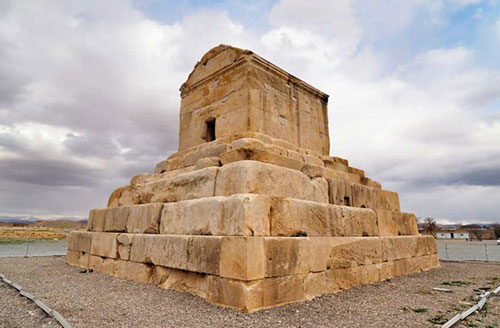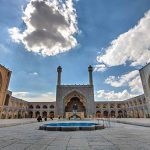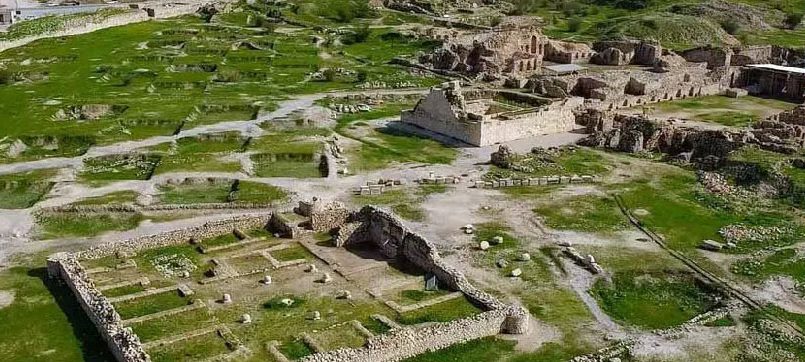Pasargadae
In Persian, called /pasargad/
The archeological site of Pasargadae, the first capital of the Achaemenid Empire, was built by Cyrus II the Great after his victory over Astyages, the last king of the Median Empire, in 546 BC. Pasargadae means the homeland of the Persian or the camp of Persia, in the Morqab Plain, Fars Province.
Dashte Morqab: the plain of Pasargadae
The architecture of this big city was inspired by Elam, Egypt, Babylon, and Assyria, as the first outstanding sample of the royal Achaemenid’s evolution of the art, architecture, and Persian civilization. The architecture’s colors consist of black and white stones. The ancestors also call the village the mother of Solomon (God prophet), Pasargad. Historically, they believed that Shiraz (Fars Province) is the kingdom of Solomon. What we know about Pasargadae today is from the excavations’ documents and written travelogues.
The Achaemenid kings’ coronation took place
in Pasargadae even after constructing Persepolis.
Pasargadae, the capital of the first great multicultural empire in Western Asia, contains fourteen ancient monuments. Its monuments were built with mud-brick, stone, and wood and adorned with inscriptions and reliefs. Each has its own story:
“I am Cyrus, king of the Achaemenids.”
The Tomb of Cyrus the Great, a father more than a king
Cyrus’s tomb is a rare example of the tradition of tomb construction in the pre-Islami. The architecture of his tomb also shows the importance and uniqueness of Cyrus. The floored Mausoleum of Cyrus the Great is built in the shape of a ziggurat in white limestone, with no kind of mortar, dates to 540-530 BC.
The first Universal Declaration of Human Rights
gave to the world by Cyrus the Great.
The tomb’s foundation area is about 156 square meters with a dimension of 12 × 13 meters. The architecture of this ziggurat-shaped monument imitated Greek art. 11 meters high building made of seven floors (steps) and an upper stone room. There are two long hollow spaces within the roof, above the tomb chamber. Ali Sami suggested queens were buried inside the roof. Gordokhtar Tomb in Bushehr Province is the smaller model of the tomb of Cyrus.
Pasargadae’s inhabitants renamed the sites with Islamic names
to prevent the destruction of the monuments.
Many years ago, people forgot who the tomb belonged to. In Qajar Period, the tomb was thought to be Soleyman’s mother, and a mosque was built around it. So, the monument was protected because of its holy. In the 19th century, archaeologists stated this place belongs to the tomb of Cyrus based on documents and inscriptions. Gardens surrounded the tomb during the Achaemenid Era. The tomb was in peace and away from looting until Alexander’s invasion.
Iranian celebrated Cyrus the Great day on 29 October.
The Tall-e Takht, Solomon‘s Throne
Tall-e Takht, as a military fortress, is the great stone platform in the northern part of Pasargadae. The history of this citadel, with 15m height, dates to the Achaemenid Period. Cyrus the Great was built in the first phase of the construction, and Darius the Great was built in the second phase with mud bricks instead of stone. The area of this monument is about two hectares. According to Stronach, we have a clear stratigraphy of Talle Takht’s construction phases.

Zendan-e Soleyman, Solomon‘s Prison
Prison is a tall stone tower in 14m height that dates to the second half of Cyrus’s reign. Some believe that the tower’s ruins are a close copy of the Cube of Zoroaster, in Persian called ka-abe Zartusht, in Naqsh-e-Rostam near Persepolis. Today you can see one wall of this tower. There are several hypotheses about the function of Zendan: the tower must have served as a fire temple, it could have been a royal tomb (the tomb of Cambyses II, the conqueror of Egypt), and others suggest that it have been a repository for important objects.
The Royal Garden, Four Gardens
The oldest creation of the Persian garden is the royal garden in Pasargadae, which dated back to 529 BC. Royal Garden has two sources of water: one for irrigation and the other for ornamental goals in pools, fountains, and waterways. Garden in Persian culture is the symbol of Eden and four holy features in the Zoroastrian religion: water, sky, earth, and plants. Four sectors division of Four Gardens (Chahar Baq) with its stone water canals designed pavilions and palaces in Pasargadae. Four Gardens Model became a prototype for Safavids and Indian Mongol architecture. The Royal Garden was registered in UNESCO as the root of Persian gardens in 2011. The Pavilions A and B were two entrances to the Royal Garden.
The Water-courses of Royal Garden
cover a length of over 1100 m.
Gate R, GateHouse
Gate R, with a columned hall and two main and side doorways, is a freestanding building. The gate is located in the east, while a pair of winged bulls adorned the outer entrance. And a pair of winged human-headed bulls situated the palaces. In one of the door jams, you can see the famous relief of the Winged Figure.
One of the most handsome pavements in Pasargadae columned-hall
Palace S, Audience Hall
The Audience Hall or Palace with the Column located between Gate R and Palace P dates back to 539 BC. Cyrus the Great welcomed and met guests of all nations in this spacious hall and spoke about human rights. So, the Audience Hall in Pasargadae is famous for The First United Nations Center. The hall was designed with eight columns (with black bases and white shafts) that each column decorated with horned and crested lions. It is a paved hall with four pairs of Reliefs that decorated the four doorways of the columned hall.
Pasargadae’s Audience Hall, The First United Nations Center
Palace P, Residential Palace of Cyrus the Great
The Palace P, also known as Private Palace, is consisted of a central hall and two large verandahs. You can see the cuneiform inscription on a pillar of this palace that says I am Cyrus, the Achaemenid King. The beginning history of Palace P is related to between 535 and 530 B.C. But, unfortunately, today, we can see the ruins of that huge palace in the northern part of Pasargadae.
A gold leaf was found during the excavation of The Sacred Precinct!
The Bridge (ruins of the spanned a large canal), The Sacred Precinct (The presence of a fireplace is evidence this area was used for worship), The Caravanserai (the monument, as a religious school, was built under Shah Shoja by transferred stones and in the 18th century became a caravanserai), Tall-e Nokhodi (the Buff Mound), Toll-e Khari (Thorny Mound), Tall-e Se Asiyab (a circular mound not yet excavated), Do Talan (Twin Mound), and Prophet Jacob’s Hill (the only hill covered by trees) are other parts of the Pasargadae complex.
Do-Tolan is the best-preserved prehistoric mound at Pasargadae.
For knowing more detailes about Pasargadae, you can read Pasargadae from Stronach, 1979. If you travel to the heartland of Persians, Pasargadae, don’t miss Hoobareh Restaurant and its Stuffed Chicken. It feels like you are walking into a Persian home.






